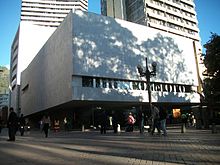Museo del Oro
The Museo del Oro (official Spanish El Museo del Oro del Banco de la República de Colombia , Gold Museum of the Bank of the Republic of Colombia ' ) is a museum with headquarters in Bogota , Colombia . It exhibits pre-Columbian finds made mostly of gold . The museum was founded by the Banco de la República , the Colombian state bank, in 1939 to protect the state's archaeological heritage.
Special objects
The collection of pre-Columbian gold objects is unique in the world and is considered the largest of its kind (35,000 pieces). The exhibits also include objects made from clay, stone, shells, wood and textiles. To be emphasized are:
- Gold raft from Eldorado : A raft made of filigree gold, 600 AD - 1600 AD from Pasca , which represents the Eldorado ceremony
- Poporo: a golden container for storing lime, approx. 500 AD from San Pedro de Urabá was the museum's first acquisition
structure
The reception and the cash desk are on the ground floor. Most of the non-gold exhibits can be seen on the first floor and an introduction to the geographical and historical context of the finds. The second and third floors contain almost exclusively gold objects.
The museum is in front of Parque Santander at a TransMilenio stop that bears the same name. The museum is managed by Clara Isabel Botero.
Regional museums
The Banco de la República also supports the following regional branch museums of the Museo del Oro:
- Museo del Oro Tairona in Santa Marta .
- Museo del Oro Zenú in Cartagena de Indias .
- Museo del Oro Quimbaya in Armenia .
- Museo del Oro en Manizales in Manizales .
- Museo del Oro Calima in Cali .
- Museo del Oro Nariño in Pasto .
- Museo Etnográfico in Leticia .
See also
Web links
- Museo del Oro Homepage (Spanish, English)
Coordinates: 4 ° 36 ′ 6.7 ″ N , 74 ° 4 ′ 19 ″ W.


